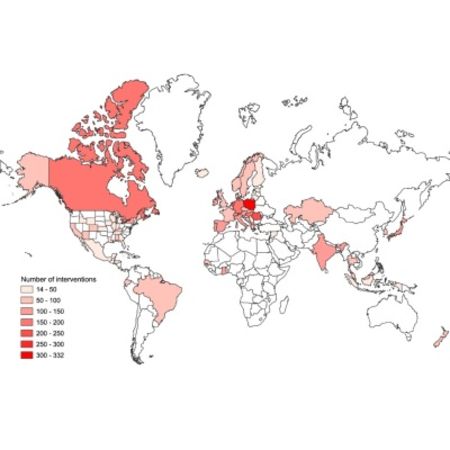Non-pharmaceutical interventions (NPIs), ranging from the most stringent lockdowns to less restrictive social distancing rules, have been implemented by different countries to control coronavirus spread and prevent COVID-19 cases overwhelming their healthcare systems.
You might also like:COVID-19 Exit Strategy Simulator Available Online
This wide variety of infection control strategies and measures has been documented and analysed by an international team of researchers (Desvars-Larrive et al. 2020), resulting in the creation of a structured open dataset called the ‘Complexity Science Hub COVID-19 Control Strategies List’ (CCCSL).
Started in mid-March 2020, the CCCSL dataset aims to improve the current knowledge on country-based interventions implemented to mitigate the burden of COVID-19. Through this database project, governments, health authorities and researchers will be able to evaluate the effectiveness of various strategies and policies to contain the COVID-19 epidemic, e.g. the epidemic growth rate or the daily reproduction numbers.
CCCSL includes a specific hierarchical coding scheme for NPIs. These codes provide an easy way to visualise the dataset. Based on the review of mitigation strategies (NPIs), eight themes – called level 1 (L1) in the coding scheme – were identified and labelled by the research team: (i) Case identification, contact tracing and related measures; (ii) Environmental measures; (iii) Healthcare and public health capacity; (iv) Resource allocation; (v) Risk communication; (vi) Social distancing; (vii) Travel restriction; and (viii) Returning to normal life.
The specific details and descriptions of each NPI were coded into ‘a priori’ categories, called level 2 (L2) in the coding scheme, and into subsequent ‘a priori’ subcategories and codes whenever needed – thereafter called level 3 (L3) and level 4 (L4) in the coding scheme, respectively.
The hierarchical coding scheme for NPIs was intended to standardise the data collection and obtain a structured dataset that uses a consistent taxonomy, and therefore promotes common understanding, the research team explained. "To improve transparency and motivate collaborative validation process, information sources are shared via an open library," the team said.
Notably, CCCSL can help with risk assessment on when some restrictions may be lifted and inform the development of exit strategies.
"We envision the CCCSL dataset to become a timely valuable and long-lasting data source for assessing the impact of the NPIs on global public health indicators, the economy, and human rights, among others," the research team points out.
The CCCSL dataset is accessible on GitHub. The dataset contains the following fields:
ID – Unique identifier for each individually implemented measure. ID is also used in the Google Form to report erroneous entries.
Country – The country where the measure was implemented.
ISO3 – Three-letter country code as published by the International Organization for Standardization.
State – Subnational geographic area. State where the measure was implemented; the country name otherwise. Used for Germany, India and the US.
Region – Subnational geographic area (e.g. region, department, municipality, city) where the NPI has been locally implemented (i.e. the measure was not implemented nationwide as of the mentioned date). The country or the state name otherwise (i.e. measure implemented nationwide).
Date – Date of implementation of the NPI. Date of announcement was used when the date of implementation of the NPI could not be found and this was specified in the field Comment.
L1_Measure – Theme (L1 of the classification scheme). Eight themes were defined (see details above).
L2_Measure – Category (L2 of the classification scheme).
L3_Measure – Subcategory (L3 of the classification scheme). Provides detailed information on the corresponding category (L2).
L4_Measure – Code (L4 of the classification scheme). Corresponds to the finest level of description of the measure.
Status – Indicates whether the measure is a prolongation of a previously implemented measure (‘Extended’) or not (‘’).
Comment – Provides the description of the measure as found in the text data source, translated into English. When available, duration of the restriction, as officially announced, is mentioned in this field.
Source – Provides the reference for each entry, i.e. URL. Enables to trace back potential changes in the meaning of the label during the translation and to access the description of the measure in the source language and/or the information as it was despatched originally.
Source: Nature
Image credit: Desvars-Larrive et al. 2020
References:
Desvars-Larrive A et al. (2020) A structured open dataset of government interventions in response to COVID-19. Sci Data, 7(285). https://doi.org/10.1038/s41597-020-00609-9



























